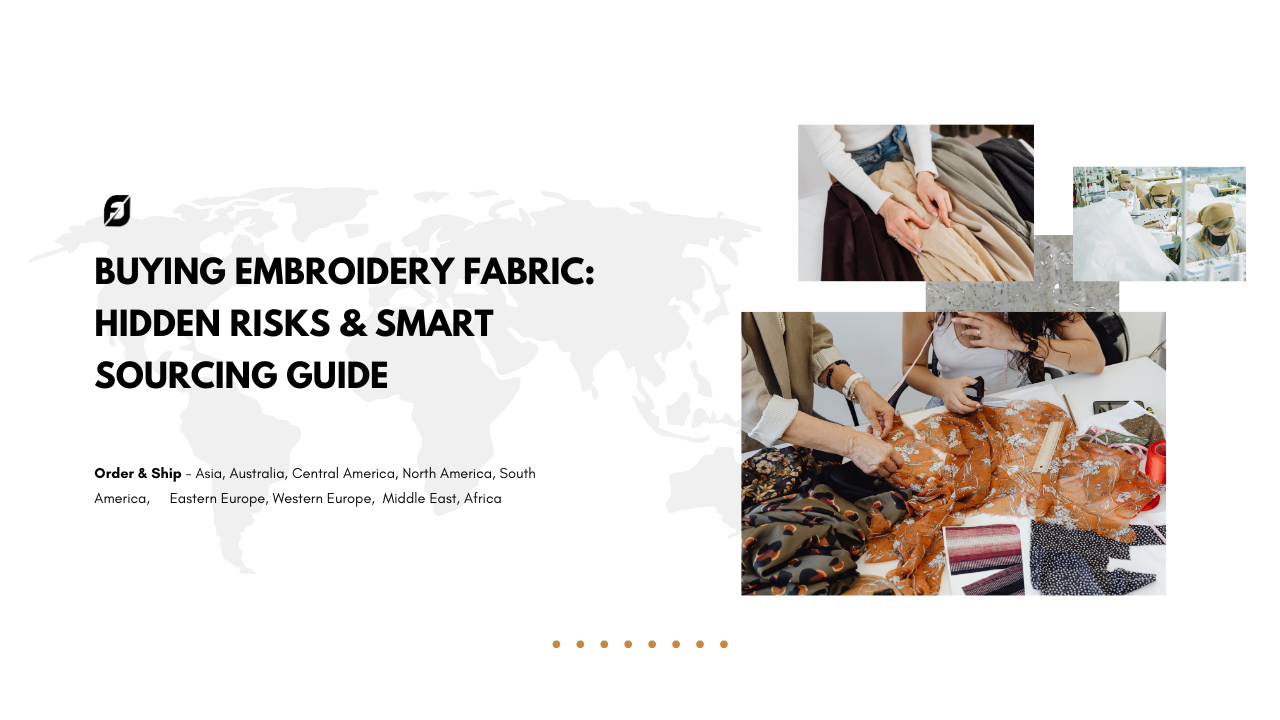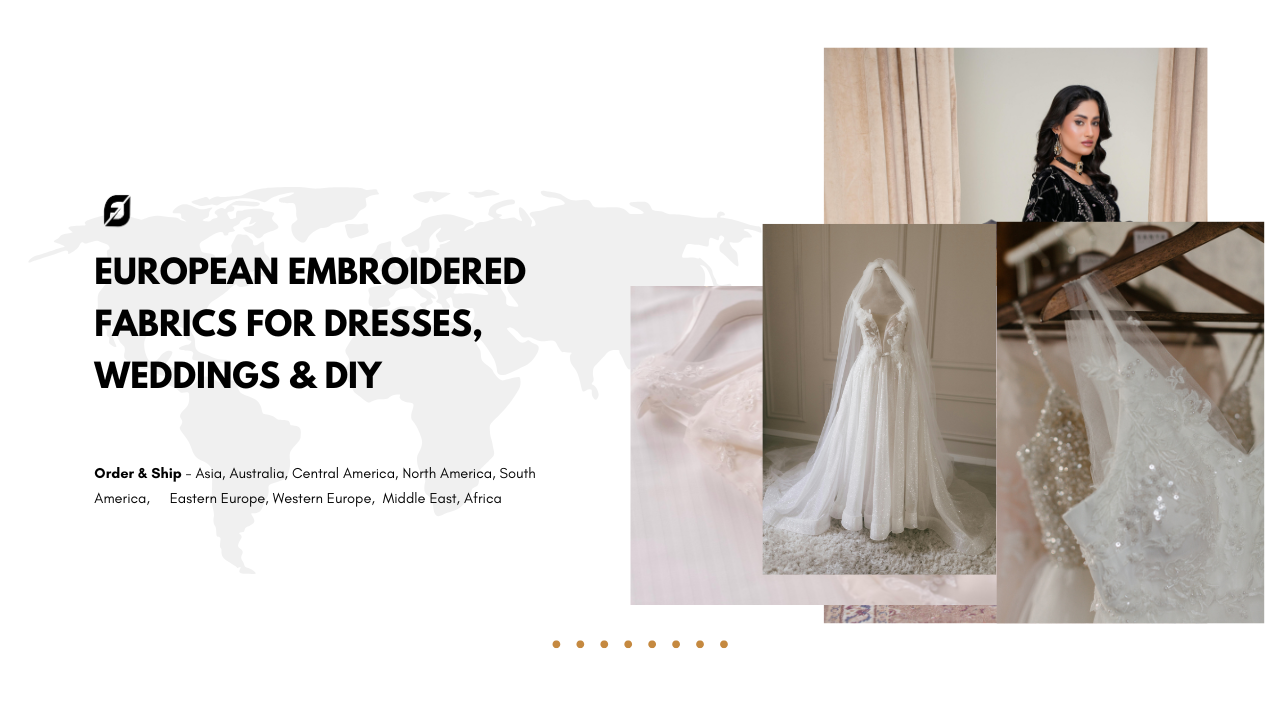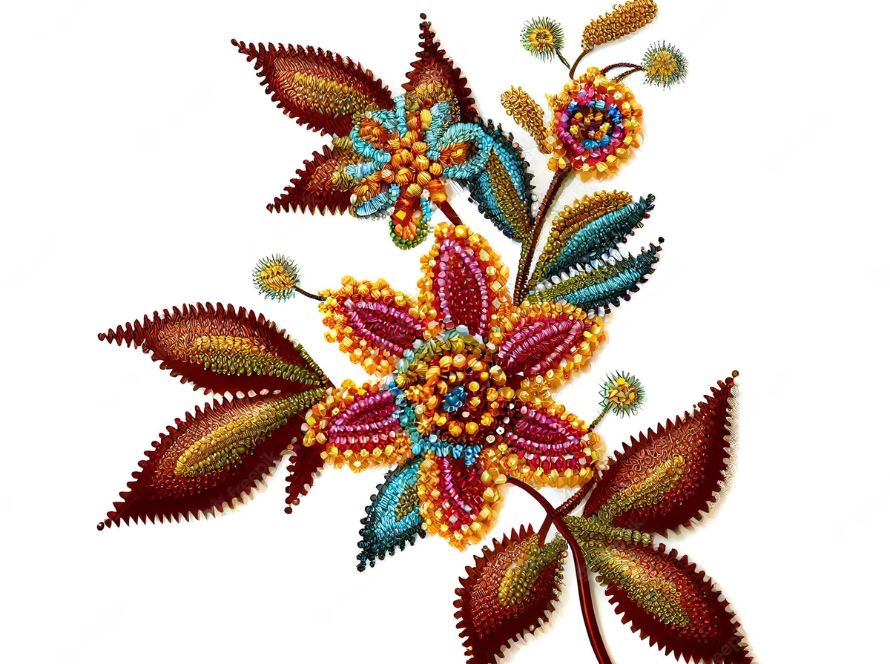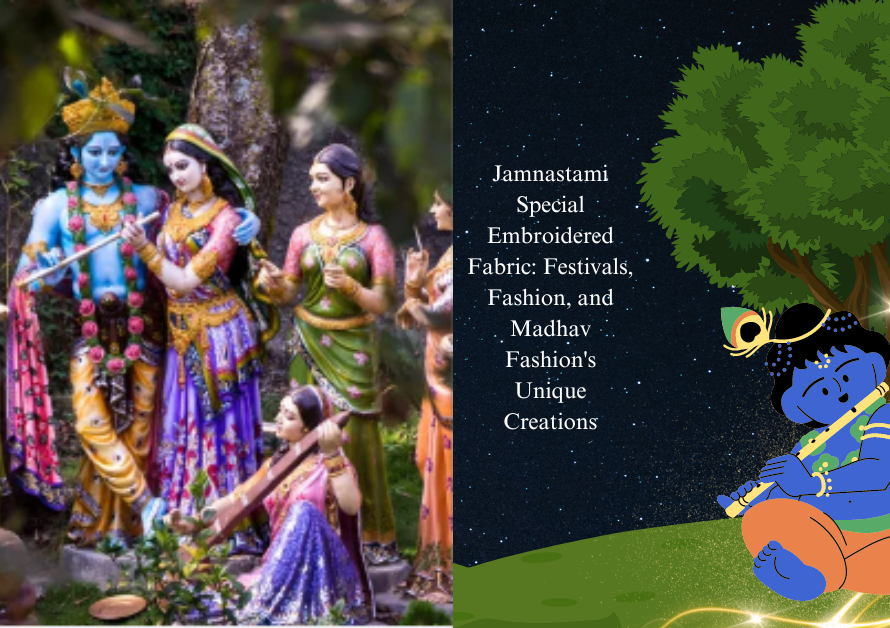Embroidered fabric for men’s garments has become a defining trend in contemporary fashion, offering a blend of elegance, tradition, and innovation.
Once confined to traditional attire, embroidery has now transcended cultural boundaries, finding its place in global fashion. Madhav Fashion, a leader in the textile industry, is at the forefront of this movement, providing high-quality embroidered fabrics that cater to designers, garment manufacturers, and boutiques worldwide.
Embroidered fabric for mens garments: A Global Fashion Sensation
The rise of embroidered fabrics in men’s fashion reflects a growing appreciation for craftsmanship and heritage. From runway collections to street style, these fabrics bring a sophisticated edge to menswear. Intricate embroidery not only enhances aesthetics but also adds depth and character to garments, making them distinctive and timeless.
Types of Embroidered Fabrics and Their Applications
A variety of embroidered fabrics serve different fashion purposes, each offering unique artistic appeal.
- Daman Embroidery Fabric – Ideal for regal kurta sets and sherwanis, featuring intricate embroidery along the hemline.
- Allover Embroidery Fabric – Perfect for statement jackets and sherwanis with embroidery covering the entire surface.
- Mirror Work Fabric – Adds a festive vibrancy to kurtas and dhotis with reflective mirror embellishments.
- Sequins Fabric – Common in glamorous evening wear, enhancing garments with a shimmering effect.
- Embroidered Kali Fabric – Essential for flared silhouettes in sherwanis and jackets.
- Embroidered Butti and Butta Fabric – Versatile choices for kurtas, jackets, and more.
- Beaded Embroidery Fabric – Used for luxurious garments with intricate beadwork.
- Gota Patti Embroidery Fabric – Traditional festive and wedding attire adorned with gold and silver ribbon work.
- Cross-Stitched Embroidery Fabric – Provides a unique texture to men’s fashion.
- Chikankari Embroidery Fabric – Delicate embroidery for elegant kurtas.
- Schiffli and Hakoba Fabric – Lightweight options ideal for summer wear.
- Jacquard Fabric – A luxurious choice for sherwanis and jackets.
- Phulkari Embroidery Fabric – Features vibrant floral embroidery for festive wear.
- Zardozi or Zari Embroidery – Rich, opulent designs for wedding attire with gold and silver threadwork.
- Cutwork Embroidery Fabric – Adds a modern touch to traditional garments.
- Aari Embroidery Fabric – Detailed embroidery commonly used on kurtas and jackets.
- Sashiko Fabric – A fusion fabric incorporating traditional Japanese embroidery.
- Kashida Fabric – Luxurious floral and paisley patterns ideal for sophisticated menswear.
- Digital Print and Position Print Fabric – Blends modern printing techniques with traditional embroidery.
Why Madhav Fashion is Leading the Trend
Madhav Fashion has established itself as a leading name in the embroidered fabric industry, recognized for its dedication to quality, innovation, and diversity. Several key factors contribute to its success:
- Unmatched Quality – High standards ensure durable and comfortable fabrics.
- Diverse Range – A wide selection of embroidered fabrics catering to various tastes and fashion needs.
- Innovative Designs – Fusion of traditional craftsmanship with contemporary trends.
- Customer Satisfaction – Commitment to excellent service and timely deliveries.
A variety of embroidered fabrics serve different fashion purposes, each offering unique artistic appeal. Daman embroidery fabric is a preferred choice for regal kurta sets and sherwanis, featuring detailed embroidery along the hemline. Allover embroidery fabric is ideal for statement jackets and traditional wear, while mirror work fabric introduces a festive vibrancy to kurtas and dhotis. Sequins fabric is popular in evening wear, providing a glamorous sheen, whereas embroidered kali fabric is essential for flared silhouettes in sherwanis and jackets.
Embroidered fabric for mens garments has become a defining element in contemporary fashion, offering elegance, tradition, and modern craftsmanship.
From sherwanis to jackets, embroidered fabric for mens garments adds sophistication and uniqueness to every outfit. Designers worldwide are embracing embroidered fabric for mens garments to create statement pieces that blend cultural heritage with modern trends.
The intricate detailing in embroidered fabric for mens garments makes them a preferred choice for festive and wedding attire. Whether it’s chikankari, zardozi, or mirror work, embroidered fabric for mens garments offers versatility for various occasions.
Fashion brands and boutiques are increasingly sourcing embroidered fabric for men’s garments to meet the growing demand for high-end and bespoke fashion.
Madhav Fashion is a trusted name in providing premium embroidered fabric for mens garments with innovative designs and top-notch quality. The luxurious appeal of embroidered fabric for mens garments makes them ideal for both traditional and contemporary outfits.
With global influence, embroidered fabric for mens garments is now seen in fusion wear across different cultures.
The craftsmanship in embroidered fabric for mens garments elevates the fashion industry’s creativity. Choosing the right embroidered fabric for mens garments ensures a timeless and stylish wardrobe.
Versatility is a defining characteristic of embroidered fabrics. Embroidered butti and butta fabric are commonly used in kurtas and jackets, while beaded embroidery fabric enhances garments with intricate beadwork. Gota Patti embroidery fabric, known for its gold and silver ribbon work, is widely chosen for wedding and festive attire. Cross-stitched embroidery fabric offers a distinctive texture for modern menswear, and chikankari embroidery fabric is prized for its delicate hand embroidery on kurtas.
Certain fabrics are favored for seasonal wear. Schiffli and Hakoba fabric, with their lace-like embroidery, are excellent choices for summer collections. Jacquard fabric, on the other hand, lends a luxurious appeal to sherwanis and jackets. Phulkari embroidery fabric, with its vibrant floral designs, is often seen in celebratory outfits. Zardozi or zari embroidery remains a staple for opulent wedding ensembles, showcasing gold and silver threadwork.
Cutwork embroidery fabric brings a contemporary twist to traditional garments, while Aari embroidery fabric is known for its detailed patterns on kurtas and jackets. Sashiko fabric, influenced by Japanese embroidery, blends seamlessly into fusion fashion. Kashida fabric, recognized for its intricate floral and paisley motifs, elevates luxurious attire. Additionally, digital print fabric and position print fabric merge modern printing techniques with traditional embroidery, expanding creative possibilities for designers.
Madhav Fashion has established itself as a leader in the embroidered fabric industry. Their commitment to superior quality, innovative designs, and a diverse range of offerings makes them a trusted choice among wholesalers, garment manufacturers, and fashion designers. With a strong emphasis on customer satisfaction, they ensure timely deliveries and maintain high production standards.
The Global Influence of Embroidered Fabrics
Embroidered fabrics are making an impact worldwide, integrating seamlessly into various fashion landscapes:
- Asia – Widely used in traditional and fusion wear, including kurtas, sarees, and lehengas.
- Europe – Increasingly incorporated into high-end fashion, evening wear, and designer collections.
- Africa – Bold and vibrant embroidered fabrics are integral to traditional attire.
- Middle East – Luxurious embroidery is a key feature in abayas and kaftans.
- American Markets – Embroidered detailing is popular in fusion wear, including jackets, dresses, and skirts.
For those in the fashion and textile business, Madhav Fashion provides bulk purchasing options for embroidered fabric, digital print fabric, and plain white RFD fabric. Industry professionals, including fabric wholesalers, exporters, sourcing managers, and boutique owners, can connect with Madhav Fashion via WhatsApp at +91-9099144005 for inquiries and orders.
The global influence of embroidered fabrics is undeniable. Across Asia, they remain integral to traditional and fusion wear, including kurtas, sarees, and lehengas. In Europe, intricate embroidery is increasingly incorporated into luxury fashion and evening wear. Africa embraces bold and vibrant embroidered fabrics in traditional clothing, while the Middle East favors opulent embroidery in abayas and kaftans. In American markets, embroidered detailing is featured in contemporary fusion wear, such as dresses, jackets, and skirts.
Embroidered fabrics in men’s fashion represent more than just a passing trend; they signify a cultural and artistic evolution. As demand continues to grow, Madhav Fashion remains a driving force in shaping the future of embroidered textiles, providing the industry with premium-quality fabrics that seamlessly merge tradition with modern aesthetics.
_____________________________
Why is embroidered fabric gaining popularity in men’s fashion?
Embroidered fabric has become a major trend in men’s fashion due to its ability to blend tradition with modern aesthetics. Unlike plain fabrics, embroidery adds texture, depth, and artistic value to garments. It transforms simple outfits into statement pieces by showcasing craftsmanship and intricate detailing.
With the rise of cultural appreciation and fusion fashion, embroidery is no longer limited to ethnic wear but is also seen in contemporary styles. Designers are incorporating embroidered elements in casual jackets, shirts, and even suits, proving its versatility. Additionally, embroidered fabrics allow for customization, enabling individuals to wear garments that reflect personal style and heritage.
The growing demand for luxury and bespoke fashion has also contributed to its popularity. High-end fashion houses and designers have embraced embroidery for its ability to enhance exclusivity and sophistication. Whether in festive attire, formal wear, or everyday fashion, embroidery adds a sense of refinement and uniqueness.
Furthermore, advancements in embroidery techniques and fabric innovation have made it more accessible and varied. From machine-made precision to handcrafted artistry, the choices are vast, catering to different tastes and budgets. This adaptability has cemented embroidered fabric as a staple in men’s fashion.
What are the different types of embroidered fabrics used in men’s garments?
A wide range of embroidered fabrics is used in men’s fashion, each offering a unique texture and aesthetic appeal. Some of the most prominent types include:
- Daman Embroidery Fabric – Ideal for kurtas and sherwanis, featuring intricate embroidery along the hemline.
- Allover Embroidery Fabric – Fully embroidered fabric used for jackets, sherwanis, and designer suits.
- Mirror Work Fabric – Popular for festive attire, decorated with reflective mirrors.
- Sequins Fabric – Commonly used in evening wear to add a glamorous touch.
- Embroidered Kali Fabric – Used in flared garments like sherwanis and statement jackets.
- Chikankari Embroidery Fabric – Features delicate embroidery, perfect for lightweight kurtas.
- Zardozi or Zari Embroidery – A luxurious choice for wedding and festive wear with gold and silver threadwork.
- Phulkari Embroidery Fabric – Vibrant floral embroidery, often used for cultural and festive outfits.
- Cutwork Embroidery Fabric – A modern take on traditional embroidery, offering a contemporary look.
These fabrics provide designers with a versatile palette to create distinctive and fashionable men’s garments that cater to different occasions and personal styles.
How is embroidery used in different men’s garments?
Embroidery is applied to various men’s garments, enhancing their visual appeal and elegance. Some of the most common applications include:
- Kurtas and Sherwanis – Embroidery is a staple in traditional and wedding wear, with intricate designs adorning collars, cuffs, and hemlines.
- Jackets and Blazers – Embroidered detailing is added to lapels, shoulders, and sleeves to elevate the sophistication of formal wear.
- Shirts – Subtle embroidery on pockets, cuffs, or collars creates a refined and trendy look for casual or semi-formal outfits.
- Dhotis and Trousers – Embroidery is sometimes used along the edges to add a unique touch to ethnic outfits.
- Scarves and Stoles – Embroidered borders and motifs make these accessories stylish additions to men’s wardrobes.
From minimalistic detailing to full embroidery coverage, the versatility of this technique allows designers to experiment with different styles, making embroidered fabrics a mainstay in modern men’s fashion.
What makes Madhav Fashion a leading provider of embroidered fabric?
Madhav Fashion has earned a reputation for providing high-quality embroidered fabrics tailored to the evolving needs of designers, manufacturers, and fashion brands. Several key factors contribute to its leadership in the industry:
- Premium Quality – Madhav Fashion ensures that every fabric meets high durability and comfort standards.
- Wide Range of Designs – From traditional to contemporary, their collection includes a vast selection of embroidery styles.
- Innovation and Craftsmanship – They blend heritage techniques with modern trends, making their fabrics versatile and unique.
- Global Reach – Supplying fabrics to wholesalers, boutiques, and manufacturers worldwide, they cater to a diverse clientele.
- Reliability and Service – Known for timely deliveries and exceptional customer service, Madhav Fashion is a trusted name in the industry.
With a commitment to excellence, Madhav Fashion continues to set trends in the embroidered fabric market.
How can designers and businesses source embroidered fabrics in bulk?
Businesses, fashion designers, and manufacturers looking to source embroidered fabrics in bulk can connect with Madhav Fashion through WhatsApp at +91-9099144005. The company offers a seamless purchasing process for large orders, ensuring quality consistency and customization options.
Customers can choose from a wide selection of embroidered fabrics tailored to various garment needs. Madhav Fashion caters to:
- Garment manufacturers producing traditional and contemporary menswear.
- Fashion designers seeking exclusive embroidery patterns for high-end collections.
- Boutiques and wholesalers looking for bulk supply of trendy embroidered fabrics.
Their streamlined process ensures that businesses receive the finest materials suited to their specific requirements.
What are the benefits of using embroidered fabric over plain fabric?
Embroidered fabric offers several advantages over plain fabric, making it a preferred choice for designers and fashion brands:
- Enhanced Aesthetics – Embroidery adds intricate detailing, making garments visually appealing.
- Personalization and Uniqueness – Custom embroidery allows designers to create exclusive and one-of-a-kind pieces.
- Luxurious Appeal – Embroidered fabric conveys sophistication and richness, elevating the garment’s value.
- Cultural Significance – Many embroidery techniques hold historical and cultural importance, adding depth to fashion pieces.
- Versatility – Suitable for various styles, from traditional wear to modern fashion.
These benefits make embroidered fabrics a timeless and fashionable choice.
How does embroidery impact global fashion trends?
Embroidery has a significant influence on global fashion, appearing in various regional styles:
- Asia – Rich embroidery in traditional Indian, Pakistani, and Chinese garments.
- Europe – Luxury brands incorporate embroidery into high-fashion collections.
- Middle East – Embroidery is prominent in abayas and festive attire.
- Africa – Bold, colorful embroidered fabrics are widely used.
- America – Fusion wear incorporates embroidery in jackets, dresses, and shirts.
This global appeal ensures that embroidery remains a relevant and evolving trend.
What are the latest innovations in embroidered fabric production?
Technological advancements have revolutionized embroidery production:
- Computerized embroidery – Ensures precision and consistency in mass production.
- 3D embroidery – Adds depth and texture to designs, enhancing fabric aesthetics.
- Eco-friendly embroidery – Sustainable threads and dyes reduce environmental impact.
- Mixed-media embroidery – Combines traditional stitches with digital printing for unique effects.
These innovations expand creative possibilities for designers while maintaining quality and efficiency.
How should embroidered fabrics be maintained for longevity?
Proper care ensures the longevity of embroidered garments:
- Hand wash or dry clean – Delicate embroidery requires gentle cleaning methods.
- Avoid harsh detergents – Use mild soap to preserve fabric color and stitching.
- Store properly – Keep garments in breathable covers to prevent dust accumulation.
- Iron with caution – Use low heat and a protective cloth over embroidery.
Following these guidelines will help maintain the beauty and durability of embroidered fabrics.






